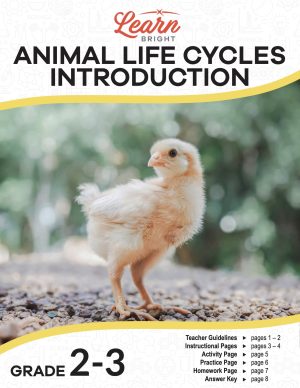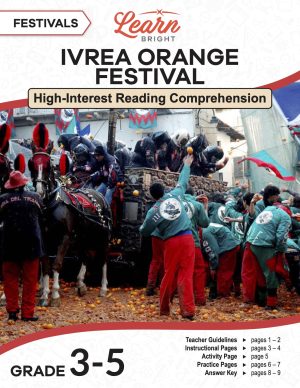Description
What our Bessie Coleman lesson plan includes
Lesson Objectives and Overview: Bessie Coleman is a high-interest reading comprehension lesson plan. As such, students will practice various close reading and comprehension skills. In addition, they will learn about Bessie Coleman and her incredible accomplishments. This lesson is for students in 3rd grade, 4th grade, and 5th grade.
Classroom Procedure
Every lesson plan provides you with a classroom procedure page that outlines a step-by-step guide to follow. You do not have to follow the guide exactly. The guide helps you organize the lesson and details when to hand out worksheets. It also lists information in the yellow box that you might find useful. You will find the lesson objectives, state standards, and number of class sessions the lesson should take to complete in this area. In addition, it describes the supplies you will need as well as what and how you need to prepare beforehand. Ensure your students have internet access for this lesson.
Teacher Notes
The teacher notes page provides an extra paragraph of information to help guide the lesson and remind you what to focus on. It explains that you can teach this lesson in a whole-class setting or as an independent, small-group activity. The blank lines on this page are available for you to write out thoughts and ideas you have as you prepare the lesson.
BESSIE COLEMAN LESSON PLAN CONTENT PAGES
Growing Up
The Bessie Coleman lesson plan contains three content pages. Do you have a goal for something you want to accomplish, like being a singer or a professional athlete? Have you ever dreamed of being a doctor and saving lives? Maybe you have seen tall buildings and wondered what it might be like to build one. Or, possibly, you have flown in a plane and thought it would be really cool to fly one yourself! If flying is your goal, then you have something in common with Bessie Coleman. She once wrote, “You’ve never lived till you’ve flown.”
To fully appreciate who Bessie Coleman was, let’s take a journey back in time. Bessie was born on January 26, 1892, in Texas. She had 12 other brothers and sisters! Her parents were Susan and George Coleman. Susan worked as a maid and George was a sharecropper.
Sharecropping was pretty popular in the rural South after the Civil War. It was a system where a farmer rented land from a landowner. The owner was then paid by taking a share of the farmer’s crops once they were harvested. That is where sharecropping gets its name. All of the Colemans’ children worked with George on the farm.
The rural South was not an easy place to live. Susan and George were discriminated against because of their race. Susan was African American, and George was both Native American and African American. Sharecropping was hard, and having a large family with lots of children to feed wasn’t easy either. In 1901, George decided to relocate the family to Oklahoma, thinking there would be less discrimination. Susan wasn’t so sure. She decided to stay in Texas and move to Waxahachie, a small town of about 4,200 people, in 1901.
Overcoming Obstacles
Life was still very hard. Bessie worked side-by-side with her mother, picking cotton and doing laundry to earn money. But Bessie had other ideas about the life she wanted. When she turned 18, she had saved enough money to attend the Colored Agricultural and Normal University (now Langston University). Unfortunately for her, she was forced to drop out of school because she couldn’t afford it anymore.
Some people might give up on their dreams when things don’t go as planned. Not Bessie! At age 23, she moved to Chicago to live with her brothers. There, she became a manicurist and worked in a local barbershop. This was around 1915, when World War I was underway. After returning from war, Bessie’s brothers shared stories about how women were allowed to fly planes in France. This was not so in the United States.
Inspired to become a pilot, Bessie applied to several flight schools in the United States. She was turned down when they discovered she was both African American and a woman. Bessie got a wild idea. If she wanted to be a pilot, she would have to go to France. She began applying to pilot schools in France. Again, another obstacle popped up to keep her from realizing her dream of being a pilot. All of the applications were written in French.
Rather than giving up her dream, Bessie took French language classes at night school. She started to apply once again, and after several rejected applications, she was accepted into flight school in France. In 1921, Bessie earned an international pilot’s license. She was finally a pilot!
Bessie Coleman, Pilot
Bessie returned to America to pursue her next dream. Later, she wrote, “I decided blacks should not have to experience the difficulties I had faced, so I decided to open a flying school and teach other black women to fly.” She didn’t just want to be a pilot. She wanted to own a plane and start a flight school. To do that, she would face more obstacles.
The first was money—owning a plane was very expensive. The second was that women-owned businesses in the 1920s were rare, and African American female-owned businesses were nearly non-existent. In the aviation industry specifically, most people believed flying was too dangerous and too complex for women. Did that stop Bessie from pursuing her dream? Nope!
Bessie began by giving speeches and presentations to crowds in churches, schools, or anywhere else someone would listen. She used local planes to perform air stunts like loop-the-loops and figure eights. In the 1920s, air shows were very popular, and Bessie drew large crowds by performing them. She toured across America and Europe doing shows, giving lessons, and thrilling the crowds with her stunts. Because she felt strongly about equal rights, she refused to speak or perform anywhere that was segregated or that discriminated against African Americans. Her popularity soared like a plane in a cloudless blue sky!
Then, in February of 1923, Bessie crashed her plane when the engine suddenly cut off in mid-flight! After a serious crash, some people might quit flying, but not Bessie. She was back in the cockpit two years later, once again flying and performing dangerous stunts for large crowds. Her hard work eventually paid off. She was able to save enough money to purchase her own plane. At last, her dream of owning an airplane was achieved! She continued to perform in air shows until April 1926.
Her Legacy
On April 30, 1926, Bessie sat in the passenger seat of a plane flown by mechanic William Wills. During the flight, a loose wrench got jammed in the plane’s control gears. Wills lost control of the aircraft and flipped upside down in mid-air. Tragically, Bessie did not have her seat belt on. She fell about 3,000 feet to her death. Wills crashed the plane and did not survive. At the young age of 34, America lost one of its great aviation pioneers, Bessie Coleman.
What is Bessie Coleman’s legacy? Queen Bess, as she was known, has been an inspiration to generations of dreamers who face obstacles while pursuing their ambitions. The Tuskegee Airmen and other groups trace their beginnings back to her. She was an outspoken leader in civil rights for minorities and women during a time in history when both were discriminated against.
As the first African American female pilot in America, she never forgot where she came from and encouraged others to follow their dreams. Bessie Coleman said, “I made my mind up to try. I tried and was successful.” Great advice for anyone with a dream!
BESSIE COLEMAN LESSON PLAN WORKSHEETS
The Bessie Coleman lesson plan includes two worksheets: an activity worksheet and a practice worksheet. Both worksheets help students solidify their grasp of the material they learned throughout the lesson. You can refer to the classroom procedure guidelines to know when to hand out each worksheet.
T-CHART ACTIVITY WORKSHEET
To better understand Bessie and her incredible life, students will list her traits and explain why they’re important. There is a T-chart on the worksheet that provides an explanation for one of these traits—perseverance. Students will list as many other positive characteristics as they can and write why those traits are good to have.
BESSIE COLEMAN PRACTICE WORKSHEET
The practice worksheet requires students to answer a series of 10 questions. These questions all relate to the content pages, so students will need to refer to them often for the answers. In addition, each question provides which reading tool the question corresponds to, such as text feature, vocabulary, or comprehension.
Worksheet Answer Keys
At the end of the lesson plan document is an answer key for the practice worksheet. The correct answers are all in red to make it easier for you to compare them with students’ responses. If you choose to administer the lesson pages to your students via PDF, you will need to save a new file that omits these pages. Otherwise, you can simply print out the applicable pages and keep these as reference for yourself when grading assignments.









